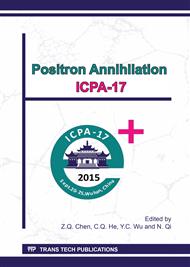p.167
p.171
p.179
p.183
p.189
p.193
p.197
p.201
p.205
Effect of FLiBe Infiltration Pressure on Microstructure of Matrix for TMSR Fuel Elements (FEs)
Abstract:
The matrix graphite of fuel elements (FEs) with infiltration of 2LiF-BeF2(FLiBe) at different pressures varying from 0.4 MPa to 1.0 MPa, has been studied by X-ray diffraction (XRD), scanning electron microscope (SEM) and positron annihilation lifetime (PAL) measurement. The result of XRD reveals that diffraction patterns of FLiBe appear in matrix graphite infiltrated with FLiBe at a pressure of 0.8 MPa and 1.0 MPa. The surface morphology from SEM shows that FLiBe mainly distributes within macro-pores of matrix graphite. PAL measurement indicates that there are mainly two positron lifetime components in all specimens:τ1~0.21 ns and τ2 ~0.47 ns, ascribed to annihilation of positrons in bulk and trapped-positrons at surface, respectively. The average positron lifetime decreases with infiltration pressure, due to the decrease in annihilation fraction of positrons with surface after infiltration of FLiBe into macro-pores.
Info:
Periodical:
Pages:
189-192
Citation:
Online since:
March 2017
Authors:
Keywords:
Price:
Сopyright:
© 2016 Trans Tech Publications Ltd. All Rights Reserved
Share:
Citation:


